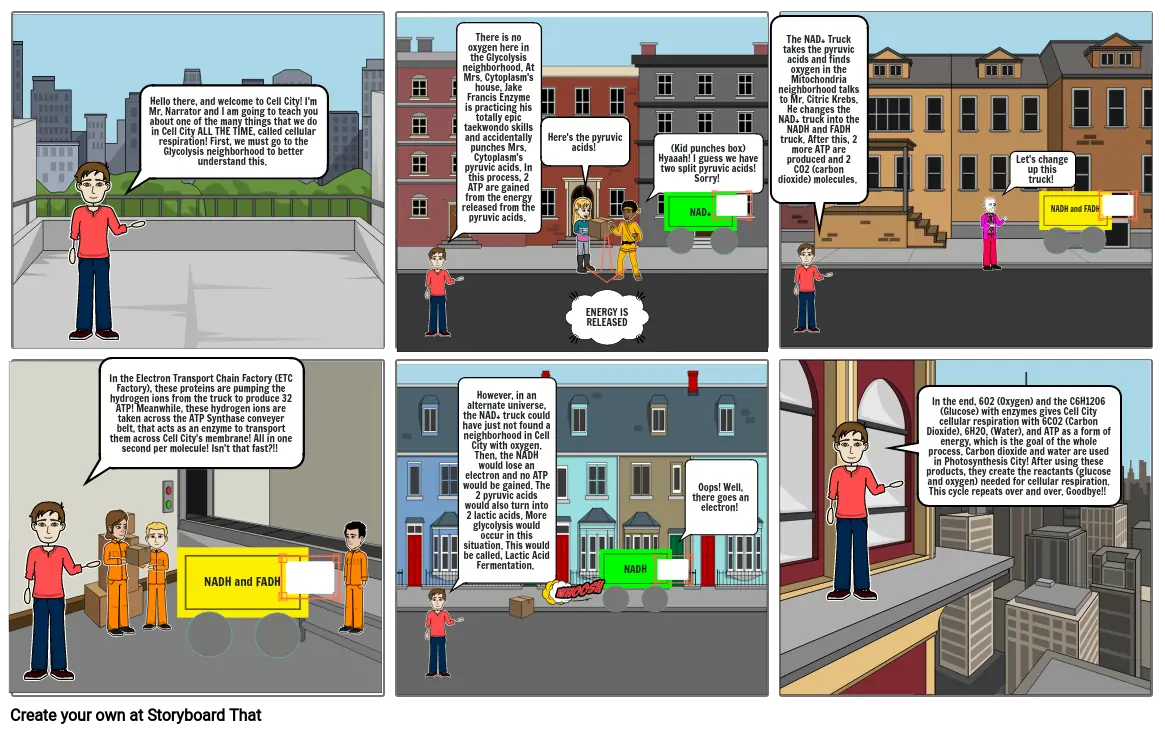Cellular Respiration Book

Storyboard Text
- Hello there, and welcome to Cell City! I'm Mr. Narrator and I am going to teach you about one of the many things that we do in Cell City ALL THE TIME, called cellular respiration! First, we must go to the Glycolysis neighborhood to better understand this.
- There is no oxygen here in the Glycolysis neighborhood. At Mrs. Cytoplasm's house, Jake Francis Enzyme is practicing his totally epic taekwondo skills and accidentally punches Mrs. Cytoplasm's pyruvic acids. In this process, 2 ATP are gained from the energy released from the pyruvic acids.
- Here's the pyruvic acids!
- ENERGY IS RELEASED
- (Kid punches box) Hyaaah! I guess we have two split pyruvic acids! Sorry!
- NAD+
-
-
-
- The NAD+ Truck takes the pyruvic acids and finds oxygen in the Mitochondria neighborhood talks to Mr. Citric Krebs. He changes the NAD+ truck into the NADH and FADH truck. After this, 2 more ATP are produced and 2 CO2 (carbon dioxide) molecules.
- Let's change up this truck!
- NADH and FADH
-
-
-
- In the Electron Transport Chain Factory (ETC Factory), these proteins are pumping the hydrogen ions from the truck to produce 32 ATP! Meanwhile, these hydrogen ions are taken across the ATP Synthase conveyer belt, that acts as an enzyme to transport them across Cell City's membrane! All in one second per molecule! Isn't that fast?!!
- NADH and FADH
-
-
-
- However, in an alternate universe, the NAD+ truck could have just not found a neighborhood in Cell City with oxygen. Then, the NADH would lose an electron and no ATP would be gained. The 2 pyruvic acids would also turn into 2 lactic acids. More glycolysis would occur in this situation. This would be called, Lactic Acid Fermentation.
- NADH
-
-
-
- Oops! Well, there goes an electron!
- In the end, 6O2 (Oxygen) and the C6H12O6 (Glucose) with enzymes gives Cell City cellular respiration with 6CO2 (Carbon Dioxide), 6H2O, (Water), and ATP as a form of energy, which is the goal of the whole process. Carbon dioxide and water are used in Photosynthesis City! After using these products, they create the reactants (glucose and oxygen) needed for cellular respiration. This cycle repeats over and over. Goodbye!!
Over 30 Million Storyboards Created

